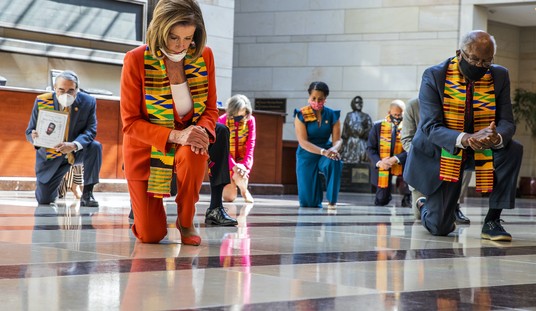It’s not easy to bring Republicans and Democrats together anymore but the malevolence and mendacity of the Chinese government have birthed an outright bipartisan miracle.
Belief in a lab leak appears to be growing on the left especially. Last year just 33 percent thought a Chinese lab was responsible for starting the pandemic, but by the end of May this year that number had climbed to 43 percent according to a poll from YouGov. Today’s survey, from Harvard/Harris, finds support rising further to majority levels. The more Americans read about the lab-leak hypothesis, it seems, they more persuaded they are.
Which is unusual in 2021, as the Harris pollster rightly notes. Virtually everything in modern American politics is polarized along partisan lines; once Republicans went all-in on the possibility of a lab accident, with Trump pushing the theory publicly, we’d expect Democrats to recoil and double down on the virus having originated in an animal in the wild instead. That didn’t happen this time.
Ironically, we may have Joe Biden to thank.
In March 2020, a Pew Research Center poll found 29 percent of Americans believed the virus was made in a Chinese lab and released either accidentally or intentionally. The new survey shows 52 percent believe the virus came out of a lab, including 59 percent of Republicans and 52 percent of Democrats, while 28 percent said it was from an infected animal…
“Usually, our polls find a big split between Republicans and Democrats, so this is unique,” [pollster Bob Blendon] said. “More conservative media have been carrying the ‘lab leak’ issue, and it’s been a Trump talking point from the beginning, so we expected people who lean Democratic would say either ‘It’s not true’ or ‘I don’t know.’ But the belief is bipartisan.”
Blendon said Democrats likely became more receptive to the idea after President Joe Biden’s recent order that intelligence agencies investigate the virus’ origin and comments from Anthony Fauci, the White House chief medical officer, that it’s worth digging into. Fauci and other scientists have cautioned the answer may never be known definitively.
It wasn’t just Biden’s order that mainstreamed the theory among Dems, I think. Nicholas Wade’s compelling, scientifically literate argument in favor of a lab leak appeared in early May and was followed soon after by the letter published in Science magazine by a group of experts urging reconsideration of the possibility. Those two pieces made it respectable for people who dislike Trump and Republicans to give the idea a second look. When Biden jumped in by ordering a new review of the intelligence and Fauci changed his tune in interviews, urging a full investigation, that was final “permission” for Dems to jump ship.
A few days ago WaPo published a story about the mystery of COVID’s “patient zero.” The first confirmed case in China was an accountant who developed symptoms on December 8, 2019, a man who didn’t shop at the Huanan seafood market that’s been called the likeliest spot for the virus to have jumped from an animal to a human. The accountant shopped at a supermarket. But just because he’s the first confirmed case obviously doesn’t mean he was the first case, period. Given that asymptomatic carriers can transmit the virus, it’s likely that he picked it up from someone he knew. Maybe they had no symptoms or maybe they were under the weather with what they thought was the flu. (“China was in the thick of its worst flu season in more than a decade” in late 2019, WaPo notes.) But that raises the question: If it was circulating before December 8, which it almost certainly was, how long before December 8 was it out there infecting people?
There are tantalizing clues from other countries that SARS-CoV-2 may have hopped China’s border and made it to Europe before the outbreak in Wuhan that ignited the pandemic:
Three days before Patient S01’s symptoms began, on Dec. 5, 2019, an oral swab was taken from a 4-year-old boy outside of Milan who was suspected of having measles. Months later, it tested positive for coronavirus RNA. The case, outlined in the Emerging Infectious Diseases journal, is one of several European studies suggesting the virus may have circulated undetected overseas for weeks, even months.
Researchers in France say they found hints of the virus even earlier, in November. A team from France’s National Institute for Health and Medical Research and other institutes retrospectively examined over 9,000 serum samples banked as part of a public health project from November 2019 through March 2020…
Then there is the most controversial study: In a paper published in November, researchers in Italy reported traces of the coronavirus in September 2019, declaring it may “reshape the history” of the pandemic. Scientists from the National Cancer Institute of Milan and the University of Siena analyzed nearly 1,000 blood samples collected in 2019 from a cancer-screening trial. They reported more than 10 percent containing coronavirus antibodies, including samples from September 2019.
Researchers are working to try to corroborate the Italian findings. Is it possible that the virus originated outside of Wuhan — or China — and was imported there? Unlikely, says WaPo, because the genome for SARS-CoV-2 closely resembles the genome of bat viruses found in China, including the original SARS. But then how did it get to Europe before the maelstrom of December 2019 began? One possibility is that whatever was circulating at the time was a less transmissible precursor of SARS-CoV-2 that mutated into its final highly contagious form sometime late in 2019. One computer model noted by the Post found that transmission of the virus petered out two-thirds of the time in 1,000 simulated outbreaks so it wouldn’t necessarily be surprising if someone brought it from China to Europe and then it fizzled there before the Wuhan eruption in December.
But if the virus was in Europe months before the pandemic began, that complicates the lab-leak theory, no? The allure of that theory is its geography: There’s a research lab studying dangerous bat viruses right in the middle of the city where SARS-CoV-2 emerged in December 2019. It’s child’s play to imagine a researcher getting infected in a lab accident and then carrying the virus out with them into the surrounding neighborhood. The timeline favored by lab-leak proponents also makes November 2019 a big month, as that’s when three employees at the Wuhan Institute of Virology allegedly needed “hospital care” for some unknown ailment. If the lab accident happened in November, it’s easy to conjure a scenario in which the sick researchers end up infecting their families or friends or even health workers who were treating them, and suddenly COVID was off and running.
Whereas if people were getting infected in Italy or France as far back as November or September, there’s no obvious reason to connect that to the WIV or even to Wuhan. Maybe there really was a zoonotic “leap” from an animal to a human somewhere in China last fall, the virus began circulating in small pockets of the population and was mistaken for flu, and a few international travelers picked it up and carried it abroad. As it continued to circulate in China, someone may have carried it to Wuhan — a city more populous than New York — and it finally took off there, possibly mutating to become the very infectious virus we know today.
As it happens, a few days ago a group of 21 virologists published a short paper making the case for the virus having originated in an animal, in the wild, rather than at the lab. Four of the authors signed the infamous Lancet letter last year that dismissed lab-leak believers as conspiracy theorists, but interestingly one author signed the letter in Science magazine two months ago that lent the lab-leak theory new credence. He’s now signing on to the zoonotic-origin theory in light of some new evidence about what kinds of animals were being sold in Wuhan’s seafood market:
Among other reasons for Dr. Worobey’s shift was the growing evidence about the Huanan animal market in Wuhan. When the pandemic first arose in Wuhan, Chinese officials tested hundreds of samples from animals sold at the market and did not find the coronavirus in any of them.
But last month a team of researchers presented an inventory of 47,381 animals from 38 species sold in Wuhan markets between May 2017 and November 2019. It included species like civets and raccoon dogs that can act as intermediate hosts for coronaviruses.
Dr. Worobey called that study “a game-changing paper.”
He also pointed to the timing of the earliest cases of Covid in Wuhan. “The Huanan market is right at the epicenter of the outbreak, with later cases then radiating outward in space from there,” Dr. Worobey said in an email.
Were the Wuhan cases really the earliest cases, though? That’s the question WaPo’s story is asking. Here’s the study, by the way, which is interesting and jargon-y but not so jargon-y as to be indecipherable. The key bit:

They haven’t found the virus in an animal yet but they did find it at the market where wild animals are sold. As for the lab-leak possibility, the authors deal with that mainly by noting that there’s just no evidence — no record that the WIV had SARS-CoV-2 on hand and no reason to think they would have or could have engineered it, even by using gain-of-function techniques. If that had happened, the authors say, we would expect the earliest samples of the virus taken from humans to have certain telltale aspects in its genome showing that it had passed through animals, probably rodents, in the lab. But we don’t see that.








Join the conversation as a VIP Member